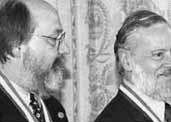Exposition
Operating Systems
Operating Systems
 The beginnings
The beginnings
Until the 50’s, the computers were programmed to do tasks in analogical mode by connecting wires and unplugging them, in short, operating systems were not perform these tasks automatically. Since 1955, it was develop a small programs that controlled the programs ran at the mainframes. The first operating systems were specific to each computer, if the computer was change, it was necessary to change the operating system and programs too.

I n 1964, IBM put on sale the 360 system, which was compatible the operating systems and programs with the different settings available in the mainframe. Despite of its large size and complexity, the 360, was successful because it opened the door to modern operating systems.
The Multics system, developed between 1964 and 1969, represented a revolution, but their ambitious goals led to complicate the design too much, eventually the expectation did not meet with the reality. Over time, the computers started to be smaller, cheaper and be able to install different versions of commercial operating systems, mainly Unix. This led the PC world, where very different operating systems (like MS-DOS, Windows, Linux or OS / 2) coexist simultaneously, but specific platforms, such as Apple, still use a proprietary operating system.
 The Unix operating system
The Unix operating system
After the retirement in 1969 of the Multics project at Bell Laboratories (Multiplexed Information and Computing Service), Ken Thompson and Dennis Ritchie, labs researchers, continue independently with the idea of a multiuser and multitask operating system. To perform its programming they used the ‘B’ program language and a PDP-7 computer. The new operating system, finished in 1970, humorously was called Unics (UNiplexed Information and Computing Service), in reference to Multics. Did not take long until it was written as: Unix.

In 1973 it was already installed in 16 companies and six months later, due to an article published in the journal Communications of the ACM , there was a flood of requests for purchase. In the following years many versions emerged, such as Solaris or Xenix System V, always oriented to the market for big servers and professional machines, turning Unís in one of the most important operating systems of history.
 The Windows operating system
The Windows operating system
Due to the success and influence of the graphical operating system of Apple Macintosh, Microsoft started in 1981 the development of a graphical manager for MS-DOS, which later was called ‘Windows’. The launch to the market, was delayed until the end of 1985, with a discrete sales. Microsoft launches multiple versions, until 1995 when fused the MS-DOS and Windows interface, to produce a domestic version. This product was called Windows 95, which was an operating system itself. The right marketing’s policies and alliances of Microsoft, led this operating system to the top of global software sales. Later the company launched to the market other products such as Windows 98 and Windows Milenium.
At the same time, Microsoft was selling Windows NT, with the same graphical layout of Windows 95, but using the design ideas of the VMS operating system. This operating system was deeply redesigned to produce a new operating system called Windows 2000, which was on the market until October 2002. Microsoft decided to unify those two families of operating systems in one, and launched the new operating system under the name Windows XP..

 The Linux operating system
The Linux operating system
Linux was born at the hands of Linus Torvalds, which was a finnish university student. In 1991 Linus decided to develop the kernel of his own operating system as a hobby. This was based on the Minix operating system, designed by Andrew Tannenbaum. Linus started this task, asking questions on internet. Until August 1991, he did not complete the first version. The name of the new operating system was Linux, but Torvalds considered at the beginning some other names, as Freax, by free (free) + x.

After several system revisions, errors has been gradually corrected, on 1994 the version 1.0 of Linux Kernel was officially released. At that time, many companies or individual groups (such as Red Hat, Debian, SuSE, Caldera and Mandrake) developed their own applications and environments. The wide range of environments and computers on which could be installed and especially the fact that it is free of charge, has made of Linux one of the most extended operating system in the world

